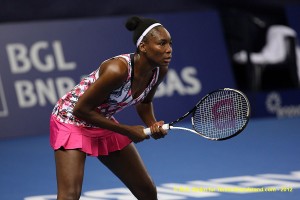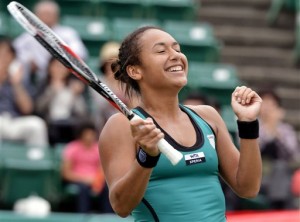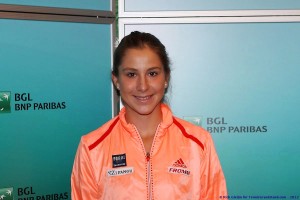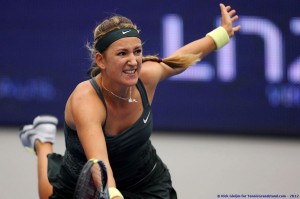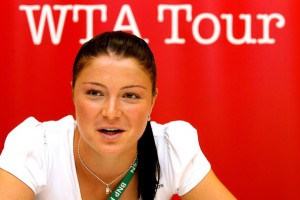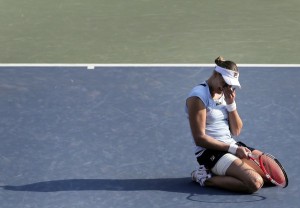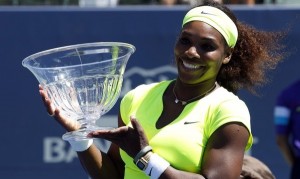By Jane Voigt owner of DownTheTee.com
October 25, 2012 — No one would deny the level of play. Each match is as good as a semifinal or final at a major tournament. And the elite 8 women who arrived in Istanbul earlier this week will be awarded generously for it. For their week’s performances. For their year of round-the-clock work.
But is it all worth it?
Maria Sharapova can’t grab a cup of coffee without being recognized. Serena Williams once hired body guards. Li Na is the most popular face in China. She admitted that winning Roland Garros in 2011 changed her life. Everyone wanted more of her.
The same scenarios can be drawn for Victoria Azarenka, especially when she’s home in Belarus. Samantha Stosur is an Australian love, Sara Errani is Italy’s darling, and Agnieszka Radwanska the same for the Poles as is Angelique Kerber for Germans.
The Green Stuff
Money is a big fat reward for these women, and huge incentive to remain at the top of the rankings’ heaps. The fact that all eight women in Istanbul were the top eight money earners on tour shouldn’t come as a surprise. Hard work yields hard cash.

The highest income winner was Victoria Azarenka, according to the WTA. She hauled in just under $7 million in singles, and a combined $11,000 in women’s and mixed doubles. Merge match money with endorsements from Nike, Citizen Watch, Wilson Racquet Sports, and American Express, et al, and her revenue jumps another $3 million. Pretty nice for the 23-year-old.
Maria Sharapova, though, is the biggest money earner of the eight. Forbes named her the top paid woman athlete in 2012 for the eighth year running. Her take … $27.1 million. Li Na is second, again according Forbes, with $18.4 million. Then there’s Serena Williams at number three with $16.3 million, and Caroline Wozniacki at number four with $13.7 million.
Tennis has been very very good to these women.
The Sine Qua Non of The Top Eight
Winning titles has to be the pinnacle of personal prizes. It drives their destiny with rocket fuel. Describing the sensation, experience, and release from a squeak-through win at a major could be compared to heaven on earth for these women. They are competition to the 10th power. Their desire to one-up an opponent has become part and parcel of their bodies and minds. When all the elements of their sport come together, and the zone has become you … nothing else prevails. Again … heaven on earth.
The Downside
People who make money and are privy to mind-blowing athletic achievements also work the hardest. It’s not difficult to comprehend. But fans quickly forget as prep time disappears when lights go up on the courts of sport entertainment.
The time these women spend in the gym now exceeds practice time on the courts, which can top six hours, or more, per day. Then there’s the travel, lugging suitcases through international airports at all hours of the day and night. Match play week after week can leave them exhausted both physically and mentally, too. What about press conferences? They are certainly easier after a win but remain mandatory. Sponsor commitments, just like those from the media, gobble up time.
Petra Kvitova pulled out of these championships Tuesdat after her first-round loss to Radwanska. She cried from disappointment and an aggravated respiratory illness for which her doctors have prescribed bed rest. Kvitova was the defending champion and wants desperately to compete in the Fed Cup finals against Serbia in two weeks. Was her year too demanding?
This spring at Family Circle Cup, Lucie Safarova, Kvitova’s Fed Cup teammate, was asked during a pre-tournament media hour what she would love to do if she wasn’t playing tennis. Her face went blank, her shoulders slumped. She would visit her mother, play with nieces, sleep in her own bed.
Privacy goes out the window with fame and fortune, too.
Maria Sharapova is asked about her life outside tennis, but prefers not to answer … unless she’s in a good mood and giggly.
Caroline Wozniacki, who was part of the 2011 year-ending championships, and Rory McIlroy, her number-one-in-the-world golfer boyfriend seem oddly comfortable in the public’s eye. Perhaps the fact that they’ve been the focus of fans, photographers, and the press all their lives has lessened their aversion.
So … is it worth it?
Yes. Although the drawbacks can be irksome, the rewards come out on top.
The competition, the love of the game, and the desire to win motivates the best. Their support teams are along to coach, aid their health, and bolster psyches. The journey is arduous and impossible alone.
Maria Sharapova’s piercing tennis cry has been as much a part of her life as her backbone. She knows nothing else aside from tennis. So whether it’s worth it could be a mute question.
Surely she will face that question, though, as will all the women in Istanbul. The signs will appear naturally. And they will then conclude what Kim Clijsters realized. That other priorities exist. That bodies slow. That life off the tennis courts could be a new challenge and chapters for already abundant lives.
Jane Voigt lives, breathes and writes tennis. She wrote about John Isner’s ground-breaking wildcard run at the formerly named Legg Mason Tennis Classic in 2007 for Tennis.com. She has written tennis commentary for the late, great Tennis Week print publication and online version. Hundreds of articles from Jane have been seen on TennisServer.com, too. She now maintains her own website at DownTheTee.com, and has traveled throughout the U. S. and Canada to cover tournaments. Ask her to play tennis, and she’ll prefer singles to doubles.


